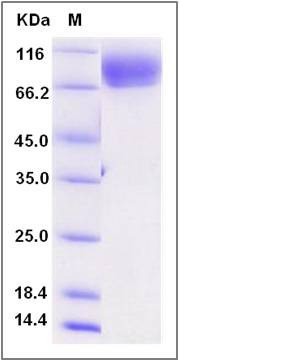Rat ALCAM / CD166 Protein (His Tag)
ALCAM
- 100ug (NPP2974) Please inquiry
| Catalog Number | P80221-R08H |
|---|---|
| Organism Species | Rat |
| Host | Human Cells |
| Synonyms | ALCAM |
| Molecular Weight | The recombinant rat ALCAM comprises 511 amino acids and predicts a molecular mass of 57.5 kDa. The apparent molecular mass of the recombinant protein is approximately 68-91 kDa in SDS-PAGE under reducing conditions due to glycosylation. |
| predicted N | Trp 28 |
| SDS-PAGE |  |
| Purity | > 98 % as determined by SDS-PAGE |
| Protein Construction | A DNA sequence encoding the rat ALCAM (O35112) (Met1-Lys527) was expressed, fused with a polyhistidine tag at the C-terminus. |
| Bio-activity | Immobilized rat ALCAM-His at 10 μg/ml (100 μl/well) can bind mouse CD6-Fc (P50711-M02H), The EC50 of mouse CD6-Fc (P50711-M02H) is 0.08-0.18 μg/ml. |
| Research Area | Developmental Biology |Embryogenesis |Germ Layer Formation |Mesoderm Marker |
| Formulation | Lyophilized from sterile PBS, pH 7.4 1. Normally 5 % - 8 % trehalose, mannitol and 0.01% Tween80 are added as protectants before lyophilization. Specific concentrations are included in the hardcopy of COA. |
| Background | Activated leukocyte cell adhesion molecule (ALCAM)/Cluster of differentiation (CD166) is a type I transmembrane cell adhesion molecule belonging to the Ig superfamily and a ligand for CD6 that is expressed on T lymphocytes. The extracellular domain of ALCAM contains five Ig-like domains (three Ig-like C2-type domains and two Ig-like V-type domains), of which the amino-terminal V1 domain is essential for ligand binding and ALCAM-mediated cell aggregation. ALCAM mediates both heterophilic (ALCAM-CD6) and homophilic (ALCAM-ALCAM) cell-cell interactions. ALCAM/CD6 interaction plays a role in T cell development and T cell regulation, as well as in the binding of T- and B-cells to activated leukocytes. Recently, homophilic (ALCAM-ALCAM) adhesion was shown to play important roles in tight cell-to-cell interaction and regulation of stem cell differentiation. While expressed in a wide variety of tissues, ALCAM is usually restricted to subsets of cells involved in dynamic growth and/or migration, including neural development, branching organ development, hematopoiesis, immune response and tumor progression. And CD166 is regarded as a potential novel breast cancer indicator and therapeutic target. |
| Reference |
